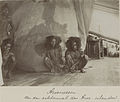Siboga expedition | |
|---|---|
 | |
| Leader | |
| Participants |
|
| Route | |
 | |


The Siboga expedition was a Dutch zoological and hydrographic expedition to Indonesia from March 1899 to February 1900.
Contents
The leader of the expedition was Max Carl Wilhelm Weber. Other members of the crew were his wife Anna Weber-van Bosse, the zoologist and first assistant Jan Versluys, the zoologist and second assistant Hugo Frederik Nierstrasz, the physician A. Schmidt, and the artist Jozef Willem Huysmans. Captain Gustaaf Frederik Tydeman was responsible for making hydrographic measurements.






